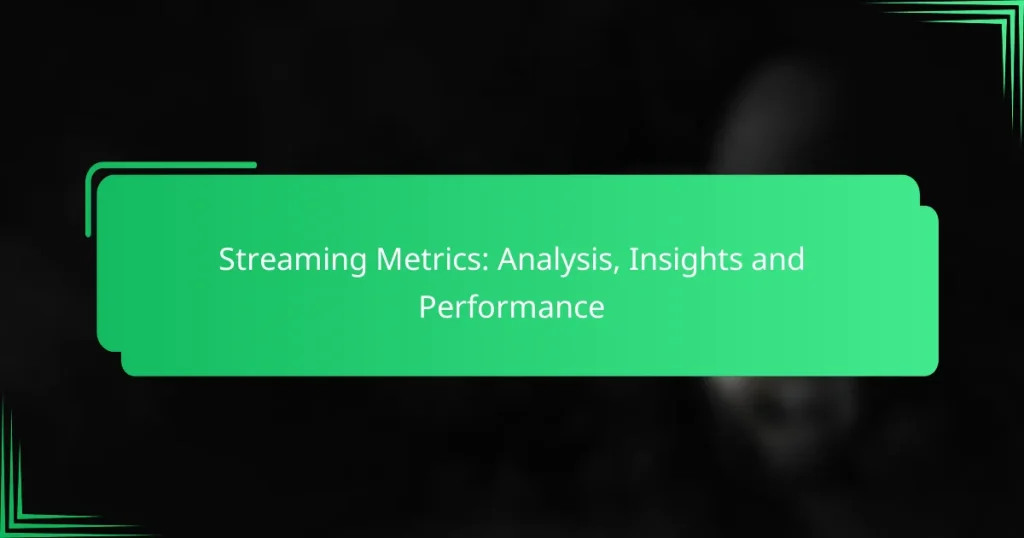Streaming metrics are crucial for evaluating the success of content delivery and viewer engagement. By analyzing these metrics, platforms can gain valuable insights into user behavior and content performance, allowing for strategic optimizations that enhance overall profitability and viewer satisfaction.

What Are the Key Streaming Metrics?
Key streaming metrics are essential indicators that help assess the performance and effectiveness of streaming content. These metrics provide insights into viewer behavior, engagement, and overall profitability, enabling platforms to optimize their offerings.
Viewership Count
Viewership count refers to the total number of unique viewers who watch a particular piece of content. This metric is crucial for understanding the reach of a show or movie and can vary significantly based on the platform and content type.
To effectively analyze viewership, consider tracking both live and on-demand views. For instance, a popular series may attract millions of views during its premiere but see a steady increase in on-demand views over time.
Engagement Rate
The engagement rate measures how actively viewers interact with content, typically expressed as a percentage of total viewers. High engagement often indicates that the content resonates well with the audience.
Engagement can be assessed through metrics such as likes, shares, comments, and time spent watching. For example, a streaming service might find that content with an engagement rate above 30% tends to lead to higher subscriber retention.
Average Watch Time
Average watch time indicates the mean duration viewers spend watching a piece of content. This metric helps gauge viewer interest and content quality.
For effective analysis, compare average watch times across different genres or formats. A series might have an average watch time of 45 minutes per episode, while a documentary could average 60 minutes, reflecting differing viewer preferences.
Churn Rate
Churn rate is the percentage of subscribers who cancel their subscriptions within a given timeframe. A high churn rate can signal dissatisfaction with content or service.
To manage churn, streaming services should aim for a churn rate below 5%. Strategies to reduce churn include offering exclusive content, improving user experience, and providing personalized recommendations.
Revenue Per User
Revenue per user (RPU) measures the average income generated from each subscriber or viewer. This metric is vital for assessing the financial health of a streaming service.
RPU can be influenced by subscription fees, advertising revenue, and in-app purchases. For instance, a platform with an RPU of $10 per month may need to enhance its offerings to compete with services generating $15 or more per user.

How to Analyze Streaming Metrics Effectively?
To analyze streaming metrics effectively, focus on collecting relevant data, utilizing appropriate analytics platforms, and identifying key performance indicators (KPIs). This approach enables you to gain insights into viewer behavior and content performance, ultimately enhancing your streaming strategy.
Data Collection Tools
Data collection tools are essential for gathering metrics from your streaming services. Popular options include Google Analytics, Mixpanel, and specialized tools like Conviva or Streamlabs, which cater specifically to streaming data. Choose tools that can capture user interactions, engagement rates, and technical performance metrics.
When selecting data collection tools, ensure they integrate seamlessly with your streaming platform. Look for features such as real-time data capture and customizable reporting to tailor insights to your specific needs. Regularly review and update your tools to keep pace with evolving technology and viewer expectations.
Analytics Platforms
Analytics platforms help process and visualize the data collected from streaming services. Tools like Tableau, Power BI, and Looker provide dashboards that make it easy to interpret complex data sets. These platforms can help identify trends, viewer demographics, and content performance over time.
Consider the scalability and user-friendliness of the analytics platform you choose. A good platform should allow for easy sharing of insights across teams and support collaboration on data-driven decisions. Regularly update your analytics strategies to incorporate new features and insights from your audience.
Key Performance Indicators
Key performance indicators (KPIs) are metrics that help evaluate the success of your streaming content. Common KPIs include viewer retention rates, average watch time, and peak concurrent viewers. Establishing clear KPIs allows you to measure performance against your goals and make informed adjustments.
When defining KPIs, align them with your overall streaming objectives. For instance, if your goal is to increase audience engagement, focus on metrics like interaction rates and social shares. Regularly review and adjust your KPIs to reflect changes in viewer behavior and market trends, ensuring they remain relevant and actionable.

What Insights Can Be Gained from Streaming Metrics?
Streaming metrics provide valuable insights into user engagement, content effectiveness, and industry trends. By analyzing these metrics, businesses can optimize their offerings and enhance user experiences, leading to improved performance and retention.
User Behavior Patterns
User behavior patterns reveal how audiences interact with streaming content. Metrics such as watch time, session duration, and drop-off rates help identify which content keeps viewers engaged and which fails to retain attention.
For instance, if a significant number of viewers drop off after the first few minutes of a show, it may indicate that the content is not compelling enough. Tracking these patterns over time can help content creators adjust their strategies to better meet audience preferences.
Content Performance Analysis
Content performance analysis focuses on evaluating how specific titles or genres perform in terms of viewership and engagement. Metrics like total views, average watch time, and user ratings provide insights into what resonates with the audience.
For example, a series that consistently garners high view counts and positive feedback may warrant further investment in similar content. Conversely, underperforming titles can be reassessed or removed from the lineup to optimize the overall catalog.
Market Trends
Market trends highlight shifts in viewer preferences and industry dynamics. By monitoring metrics such as demographic engagement and platform usage, companies can identify emerging trends that may influence their content strategy.
For instance, if data shows a growing interest in short-form content among younger audiences, streaming services might consider expanding their offerings in that area. Staying attuned to these trends is essential for maintaining competitiveness in the rapidly evolving streaming landscape.

How to Improve Streaming Performance?
Improving streaming performance involves optimizing content delivery, enhancing marketing efforts, and upgrading technical infrastructure. By focusing on these areas, you can significantly enhance viewer experience and retention.
Content Optimization Strategies
Content optimization is crucial for streaming performance. This includes selecting high-quality video formats, ensuring proper encoding settings, and utilizing adaptive bitrate streaming to adjust quality based on viewer bandwidth. Aim for resolutions that balance quality and loading times, typically between 720p and 1080p for most users.
Regularly analyze viewer engagement metrics to identify which content resonates most. Use this data to curate playlists and recommend similar titles, enhancing user satisfaction and increasing watch time.
Targeted Marketing Campaigns
Targeted marketing campaigns can drive more viewers to your streaming platform. Utilize data analytics to segment your audience based on viewing habits, demographics, and preferences. Tailor your marketing messages to address these segments, promoting relevant content that aligns with their interests.
Consider using social media ads and email marketing to reach potential viewers. Offering limited-time promotions or exclusive content can also entice new subscribers and boost engagement.
Technical Enhancements
Technical enhancements are vital for ensuring smooth streaming experiences. Invest in robust Content Delivery Networks (CDNs) to reduce latency and buffering times. A well-distributed CDN can significantly improve load times, especially for users in different geographical locations.
Regularly update your streaming platform’s software to incorporate the latest features and security measures. Monitor server performance and scalability to handle peak traffic, ensuring that your infrastructure can support a growing user base without compromising quality.

What Are the Best Tools for Streaming Metrics Analysis?
The best tools for streaming metrics analysis provide insights into viewer engagement, content performance, and technical quality. Popular options include Google Analytics, which tracks user behavior, and other specialized platforms that focus on streaming data.
Google Analytics
Google Analytics is a powerful tool for analyzing streaming metrics, particularly for websites and apps. It tracks user interactions, session durations, and traffic sources, allowing content creators to understand how viewers engage with their streams.
To effectively use Google Analytics for streaming, set up event tracking for key actions such as play, pause, and completion rates. This data helps identify which content resonates most with viewers, enabling informed decisions on future programming.
Common pitfalls include neglecting to configure goals and filters, which can lead to inaccurate data. Regularly review your analytics setup to ensure it aligns with your streaming objectives and provides actionable insights.


